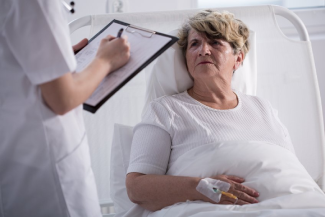Legal Perils and Pitfalls of Wound Care: Nutrition Assessment, Support, and Documentation, Part 2
August 20, 2020
Part 2 in a 3-part series looking at nutritional assessments and avoiding nutrition related litigation. Read Part 1 Here.
In the previous blog, I briefly went through the standards of care when it comes to nutrition and pressure injury (PI) prevention and development and discussed what a large role nutrition plays in PI litigation. Here are several instances: Punitive damages of $92 million, later lowered to $11,855,000, were imposed where malnutrition and dehydration were proven against a nursing home.1 A dietary manager for a nursing home told state surveyors that her nursing home had "dropped the ball" on a resident's nutrition needs when that resident had lost 17 pounds in 75 days; a $1,385,000 settlement was reached.2 Malnutrition with a loss of 27% of body weight in 15 months led to a $380,000 settlement just before trial.3 Shocking, isn't it? It literally "pays" to pay attention to nutrition standards of care.
National Pressure Injury Advisory Panel Guideline Overview
The National Pressure Injury Advisory Panel (NPIAP) recently updated the PI clinical practice guidelines, published last fall. You can order the full guideline from their website at www.npiap.com, or at the very least download a free e-version of the Quick Reference Guide. For nutrition, the guidelines have a total of 15 recommendations. Of course, remember that ultimately the recommendations don’t pertain just to PIs, but to any nutrition or wound issues in general.
Guidelines #1 to #3 The first three recommendations were covered in Part 1 of this blog, namely, Guideline #1, which is Nutrition Screening, Guideline #2, which is Nutrition Assessment, and Guideline #3, which is Nutrition Care Planning.
NPIAP Guidelines #4 to #7
The next four recommendations pertain to energy and protein intake:
#4. Optimize energy intake for those individuals AT RISK of a PI who are malnourished or at risk of malnutrition. Energy intake refers to caloric intake. A good assessment of caloric intake will give the answer to the question, "Is this patient consuming enough calories?," usually based on at least a three-day calorie count. If the patient is not meeting their needs, we need to take measures to “optimize” intake. Think high-calorie foods and ways to augment calories. Note that the current guideline in the AT-RISK category does not have any specific numeric calorie recommendations, which is a change from the 2014 guidelines.
#5. Adjust protein for individuals AT RISK of PI who are malnourished or are at risk of malnutrition. Protein intake should be 1 to 1.5 g/kg of body weight per day, providing adequate protein for positive nitrogen balance to avoid breakdown of lean body mass. Of course, assess renal function and adjust accordingly.
#6. Provide 30 to 35 kcal/kg body weight per day for adults WITH A PRESSURE INJURY who are malnourished or at risk for malnutrition. Sometimes it can be a challenge to get this many calories into a patient! We need to individualize the care plan and intake based on underlying medical conditions and level of activity. Remember to look at the total condition of the patient, not just the PI. We may need to modify or liberalize, depending on needs and patient preferences. Add fortified foods if necessary. The guidelines recommend that we consider adding oral nutritional supplements as strategies for reaching the individual’s caloric intake goals.
#7. Provide 1.25 to 1.5 g protein/kg body weight per day for adults WITH A PRESSURE INJURY who are malnourished or are at risk of malnutrition. This is an effort to move the patient from a state of catabolism (breakdown of tissue with lack of healing) to a state of anabolism (tissue buildup and repair). And as in #5, consider renal status when making recommendations, working hand in hand with a patient’s doctor or nephrologist as needed to optimize protein intake without harming kidneys.
NPIAP Guidelines #8 and #9
The next two recommendations pertain to supplementation:
#8. Offer high-calorie, high-protein fortified foods and/or nutritional supplements in addition to the usual diet for patients AT RISK of a PI. Notice that there no longer is the recommendation to provide a multivitamin as in the 2014 guidelines. Instead, we are encouraged to read labels of supplements, looking at nutrients such as protein, carbohydrates, fat, vitamins, minerals, and amino acids. Determine what micronutrients are included. Of course, a good balanced diet with regular meals and snacks is preferable, but the NPIAP is saying that if it looks as though we need to supplement, based on intake, then add go ahead and add supplements!
#9 is similar to #8, except the recommendation is for patients WITH A PRESSURE INJURY. Further guidance is to provide supplements between meals; the dosage should be two bottles per day, with an energy density of 1.5 to 2.4 kcal/mL, and to continue supplementation for at least four weeks.
Next Up
Those are the first nine recommendations; in the next blog I will continue with recommendations # 10 to # 15.
References
1. Estate of Hary v. Horizon/CMS Healthcare Corp., No. JVR-212802, 1997 WL 83167 (Tarrant Cnty. Tex. Dist. Ct. Nov. 1997.)
2. Parish v. Beverly Enters., CV-1-99-7216CC (Clay Cnty. Ct. Mo. July 2003), reported in VERDICTS, SETTLEMENTS & TACTICS 277 (July 2003).
3. Case name withheld (Franklin Cnty. Va. Circ. Ct. 2003), reported in VERDICTS, SETTLEMENTS & TACTICS 379 (Sept. 2003).
About the Author
Heidi H. Cross, MSN, RN, FNP-BC, CWON, is a certified Wound and Ostomy Nurse in Syracuse, NY. She has extensive experience caring for wound and ostomy patients in acute care as well as in long term care facilities. Currently, she is employed by CNY Surgical Physicians consulting for nursing homes in the Syracuse area, and has served as an expert witness for plaintiff and defense attorneys.
The views and opinions expressed in this blog are solely those of the author, and do not represent the views of WoundSource, HMP Global, its affiliates, or subsidiary companies.













Follow WoundSource
Tweets by WoundSource